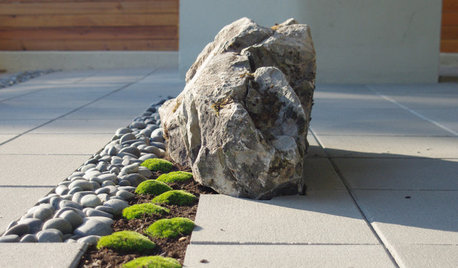Garden Center Recycling of Potting Mixes? & HVX
hostaLes
11 years ago
Related Stories

LANDSCAPE DESIGNAdd a Touch of Sparkle With Recycled Glass in the Garden
See 7 practical and versatile ways to use recycled glass in the garden
Full Story
HOUZZ TOURSMy Houzz: Mixed-Use Oregon Home Serves and Charms
Home, restaurant, garden, rental cabin — and it gives back to the community too. This multitasking home is a wonder in more ways than one
Full Story
BEFORE AND AFTERSHouzz TV: See Recycled Walls and Cool Cassette Art in a Woodsy DIY Home
Walnut countertops join hardwood floors and pieces made from leftover framing in a bright Spanish colonial
Full Story
DECORATING GUIDES8 Ways to Decorate a Center Table
Make a feature table look grand no matter what its size, with artistic arrangements of flowers, vases and more
Full Story
ART10 Homes Where Art Takes Center Stage
Homeowners’ passion for their collections drives the design of these art-filled homes
Full Story
GARDENING GUIDESVegetables and Flowers Mix in Beautiful Edible Gardens
Ornamentals, meet your edible garden mates. We know you'll get along just beautifully
Full Story
GARDENING GUIDESMix or Mass Daisies for Two Great Garden Looks
The classic daisy looks equally beautiful massed in borders or mixed throughout a naturalistic planting. Which look suits your style?
Full Story
KITCHEN DESIGNNew This Week: 2 Kitchens That Show How to Mix Materials
See how these kitchens combine textures, colors and materials into a harmonious whole
Full Story
LANDSCAPE DESIGNDare to Mix Things Up in the Landscape
Courageously contrast plantings, materials and structures in your garden to create unexpected beauty and intrigue
Full Story
ARCHITECTURECity View: New Orleans Style Mixes It Up
Always ready for a party and a parade, this Louisiana city also counts history, varied cultures and a resilient spirit among its influences
Full Story








Jon 6a SE MA
roblksd
Related Professionals
Edmond Landscape Contractors · Norwood Landscape Contractors · Bedford Heights Landscape Contractors · Fort Atkinson Landscape Contractors · Placerville Landscape Contractors · West Coon Rapids Landscape Contractors · Ridgewood Fence Contractors · Cartersville Fence Contractors · Catonsville Fence Contractors · Cutler Bay Fence Contractors · Grover Beach Fence Contractors · Piedmont Fence Contractors · Woodland Fence Contractors · Brockton Solar Energy Systems · Downers Grove Solar Energy SystemshostaLesOriginal Author
User
Jon 6a SE MA
roblksd
Jon 6a SE MA
roblksd
trudy_gw
hostaLesOriginal Author
Jon 6a SE MA
trudy_gw
trudy_gw
Jon 6a SE MA
ctopher_mi
Jon 6a SE MA
trudy_gw
Jon 6a SE MA
roblksd
Jon 6a SE MA
trudy_gw
roblksd
trudy_gw
hostaLesOriginal Author
Jon 6a SE MA
hostaLesOriginal Author
tsugajunkie z5 SE WI ♱
Jon 6a SE MA
buckeye15
hostaLesOriginal Author
Jon 6a SE MA
hostaLesOriginal Author
User
buckeye15
esther_b
Jon 6a SE MA
esther_b
hostaLesOriginal Author
Jon 6a SE MA
bkay2000
Jon 6a SE MA